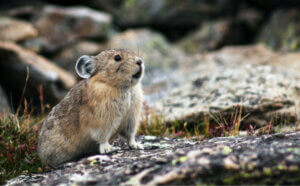Pikas or Whistle Rabbits: Habitat and Characteristics


Reviewed and approved by the biologist Samuel Sanchez
These furry creatures with teddy bear faces have been spotted several times in the high rocky mountains with green meadows of Tianshan —in northwest China. These fascinating animals hide between the rocks and make a whistling sound to attract the attention of their companions. That’s why pikas also receive the name of whistle rabbits.
Today we bring you all the information you need to know about this very small mammal, sometimes known as a pika and, in other cultures, as the whistle rabbit. What’s the reason for this peculiar characteristic of whistling? In this article, we’ll answer this question and many more.
What are pikas or whistle rabbits?
Whistle rabbits are small mammals that mainly live in the mountains. They belong to the genus Ochotona, a group of lagomorph mammals of the family Ochotonidae. These beautiful animals have the appearance of small mice or rabbits, due to their dexterous, fast movements.
Its peculiar squeak that it makes from time to time is what gives the animal its nickname of whistle rabbit. It inhabits some areas of Asia, however, there’s only one species (Ochotona pusillus) in Europe. Several other species live in North America.

Main traits
Let’s take a look at why whistle rabbits are neither mice nor rabbits, but somewhere in between the two worlds. Here are some of their traits:
- Pikas range in size from 12 to 30 cm (5 to 12 in), weighing between 100 and 300 g (3.5 to 10.5 oz).
- They have a soft, thick coat with different colors —depending on the species.
- Their ears are round and so are their eyes. These animals have a face with a short narrow snout, and a mouth similar to that of a mouse.
- This lagomorph has short limbs and also a very short tail —so short that it’s difficult to see.
- The function of the whistle emitted by pikas is multiple. They use different tones to warn of the presence of predators, to communicate, or for reproduction purposes.
- These animals are difficult to spot. Additionally, many of the species included in this taxon are in danger of extinction.
Habitat
Whistle rabbits inhabit the rocky mountainous areas of colder climates. However, some species live in forested areas. Whether in the rocks or in the forest, their goal is to make the area their home. There they hide in shallow burrows where they store their food.
They’re community-oriented creatures, as they collaborate with all the other pikas to gather food and guard against predators, such as birds of prey and carnivorous mammals. These animals feed on shrub leaves, dried vegetables, and seeds.
A curious detail about the territoriality of whistle rabbits is that they can be aggressive towards each other, sometimes with the purpose of stealing food. They have the habit of storing food in their burrows for winter, when resources are scarce.
Pikas in the mountains
Curiously, when whistle rabbits build their burrows, they’re improving the quality of the soil. When they relieve themselves, their droppings provide organic material and, as a consequence, enable plant growth in the area.
If they feel threatened at any time, they hide in their burrow and wait until they feel safe. During the winter season, whistle rabbits take advantage of their ability to move easily among the rocks in order to take shelter under them, and so protect themselves from low temperatures.

Whistle rabbits are an endangered species
These cuddly animals are very elusive. In fact, very few specimens of certain species have been seen and, as a result, not much is known about their behavior. Some species of pikas are on the verge of extinction, according to the International Union for Conservation of Nature (IUCN).
Finally, pikas are in danger of disappearing, as their natural environment has shrunk by 71%. This is due to climate change and also to forced displacement by the growing population in the mountains where this furry animal lives.
These furry creatures with teddy bear faces have been spotted several times in the high rocky mountains with green meadows of Tianshan —in northwest China. These fascinating animals hide between the rocks and make a whistling sound to attract the attention of their companions. That’s why pikas also receive the name of whistle rabbits.
Today we bring you all the information you need to know about this very small mammal, sometimes known as a pika and, in other cultures, as the whistle rabbit. What’s the reason for this peculiar characteristic of whistling? In this article, we’ll answer this question and many more.
What are pikas or whistle rabbits?
Whistle rabbits are small mammals that mainly live in the mountains. They belong to the genus Ochotona, a group of lagomorph mammals of the family Ochotonidae. These beautiful animals have the appearance of small mice or rabbits, due to their dexterous, fast movements.
Its peculiar squeak that it makes from time to time is what gives the animal its nickname of whistle rabbit. It inhabits some areas of Asia, however, there’s only one species (Ochotona pusillus) in Europe. Several other species live in North America.

Main traits
Let’s take a look at why whistle rabbits are neither mice nor rabbits, but somewhere in between the two worlds. Here are some of their traits:
- Pikas range in size from 12 to 30 cm (5 to 12 in), weighing between 100 and 300 g (3.5 to 10.5 oz).
- They have a soft, thick coat with different colors —depending on the species.
- Their ears are round and so are their eyes. These animals have a face with a short narrow snout, and a mouth similar to that of a mouse.
- This lagomorph has short limbs and also a very short tail —so short that it’s difficult to see.
- The function of the whistle emitted by pikas is multiple. They use different tones to warn of the presence of predators, to communicate, or for reproduction purposes.
- These animals are difficult to spot. Additionally, many of the species included in this taxon are in danger of extinction.
Habitat
Whistle rabbits inhabit the rocky mountainous areas of colder climates. However, some species live in forested areas. Whether in the rocks or in the forest, their goal is to make the area their home. There they hide in shallow burrows where they store their food.
They’re community-oriented creatures, as they collaborate with all the other pikas to gather food and guard against predators, such as birds of prey and carnivorous mammals. These animals feed on shrub leaves, dried vegetables, and seeds.
A curious detail about the territoriality of whistle rabbits is that they can be aggressive towards each other, sometimes with the purpose of stealing food. They have the habit of storing food in their burrows for winter, when resources are scarce.
Pikas in the mountains
Curiously, when whistle rabbits build their burrows, they’re improving the quality of the soil. When they relieve themselves, their droppings provide organic material and, as a consequence, enable plant growth in the area.
If they feel threatened at any time, they hide in their burrow and wait until they feel safe. During the winter season, whistle rabbits take advantage of their ability to move easily among the rocks in order to take shelter under them, and so protect themselves from low temperatures.

Whistle rabbits are an endangered species
These cuddly animals are very elusive. In fact, very few specimens of certain species have been seen and, as a result, not much is known about their behavior. Some species of pikas are on the verge of extinction, according to the International Union for Conservation of Nature (IUCN).
Finally, pikas are in danger of disappearing, as their natural environment has shrunk by 71%. This is due to climate change and also to forced displacement by the growing population in the mountains where this furry animal lives.
All cited sources were thoroughly reviewed by our team to ensure their quality, reliability, currency, and validity. The bibliography of this article was considered reliable and of academic or scientific accuracy.
https://es.wikipedia.org/wiki/Ochotona
https://www.ngenespanol.com/naturaleza/el-mamifero-que-eludioalaciencia/
https://www.bbc.com/mundo/ultimas_noticias/2015/03/150328_ciencia_conejo_viral_chino_piki_amv
https://mamiferos.paradais-sphynx.com/lagomorfos/liebres-silbadoras-pika.htm
https://www.agenciasinc.es/Noticias/La-pica-americana-adapta-su-estilo-de-vida-al-cambio-climatico
This text is provided for informational purposes only and does not replace consultation with a professional. If in doubt, consult your specialist.








